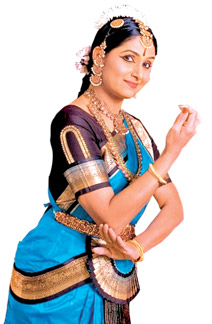The influence of Bharatha Natyam
Subashini PATHMANATHAN
Different designs in Hindu temples
* Thiru Koneswar in Trincomalee
* Sri Muneswaram temple in Chilaw
* Thiru Ketheswaram in Mannar
* Kathirgama / Kataragama temple of Sri
Skanda
* Nallur Kandaswamy Temple
* Sri Murugan Temple in Mavettapuram,
Kankesanthurai
* Meenaksshi Sundereswar in Galle,
* Thanthoneswarar temple in eastern Sri
Lanka
* Ponambalawaneshwarar temple in Colombo
Bharatha Natyam is a Hindu temple dance form. It originated in
ancient temple culture and in the mid 20th century it moved to stages.
Its repertoire (the traditional order of the items) is based on Hindu
temple structure. The temple structure is totally based on Hindu Akama
and Sastra. This dance form is completely based on Hinduism. Besides
this art form is a Tamil classical dance form. Therefore to understand
this art one must have good command of Hinduism and Tamil Language.
Otherwise it is hard to understand and research the art. Bharatha Natyam
originated from the temple dance Sathir.
 |
|
Dancer’s
elegance |
First Hindu temples must be identified across the country. The Hindu
temples must then be categorised into different divisions during the
study program. The important temples include historically old and
geo-political places: Thiru Koneswar in Trincomalee, Sri Muneswaram
temple in Chilaw, Thiru Ketheswaram in Mannar, Kathirgama / Kataragama
temple of Sri Skanda, Nallur Kandaswamy Temple, Sri Murugan Temple in
Mavettapuram, Kankesanthurai, Meenaksshi Sundereswar in Galle,
Thanthoneswarar temple in eastern Sri Lanka, Ponambalawaneshwarar temple
in Colombo and other numerous Chitralayas (art and sculpture based
temples).
Earlier the sources of materials to construct the temples were clay
and bricks. But with the passage of time granite stones were used. These
granite stoned buildings are long-lasting. Today cement mixture is the
main material for temple constructions all over the world.
Most Hindu temples in the Dravidian belt have typical Dravidian
architecture with sculpture and art (drawings). These can be found at
the pillars, madapams (halls), Vimanams and Raja Gopurams. Unlike Indian
temples, the Hindu temples in Sri Lanka do not have many interior
verandahs, mandapams or halls. There are three inner circles of
verandahs or veethis found at the ancient South Indian temples as
compared to Sri Lankan temples. The temple art and sculptures in Sri
Lanka are usually found mostly at the entrances.
Just outside the sanctum of each god and goddess (temple guards are
known as Dwara Balakars), vimanams, Raja Gopurams, mani gopurams, mada
gopurams, chithirai-Ther (crafted temple cars), large various types of
temple car/carts, temple car sheds, temple gardens, pillars of the halls
and Dheertha Kerni ( Holy temple pond) are decorated with beautiful
sculpture. They are also decorated with special female dance sculptures
well preserved at the personal custody of the temple administration.
Some of these structures can also be seen at the ancient ruined palaces,
archaeological museums and art galleries. To understand the development
of Bharatha Natyam in Sri Lanka, one has to understand history,
development and influence of Hinduism in Sri Lanka. The scholars can
easily identify and understand under which regime and under which period
by whom these temples were built. To understand one must study or take
into account about the comparative cultural studies, which took place at
different periods, different areas and in different geographical
regions.
The above factors are important to understand origins, modifications
and transitions which took place according to the needs of different
periods and different cultural influences. Most of these figures express
the messages through different dancing postures based on Tamil classical
dance called ‘Bharatha Natyam’. These poses convey the messages
particularly through abhinayas, beautiful dance poses, body angle
positions, or through different hand gestures. Bharatha Natyam postures
show magnificent changes not only occurred at regional levels but also
in different cultural periods.
As compared to other forms of traditional dances in South Asia, the
pure traditional classical Bharatha Natyam has shown many changes
throughout the ancient human civilization. It is noticeable that at
times some dance poses of different regions in Sri Lanka show some kind
of add-mixture or influence of other regional and the native classical
dance influences.
Another important aspect of the present study of the ancient Hindu
temple dance sculptures of Sri Lanka help us understand the dresses and
ornaments worn in different eras in the ancient Hindu temple sculptures.
These are obviously clear in the sculptures. The Sri Lankan based
study on Hindu temple sculptures start from the temples built in 10th
century.
A primary study (personal communication based on unpublished data) in
this regard with an expert reveals interesting and astonishing facts
about the age old Hindu temple art gallery and sculptures narrating the
sequences of evolution and various transitional stages. When we take
into account about the Sri Lankan temple sculptures it is a must that we
have to study the South Indian Hindu temple Dravidian structures and
temple sculptures.
Mahabalipuram, Thillai Natraja temple at Chidambaram, Madurai
Meenakshi temple, Chola’s Tanjavore Periya Kovil (housed world famous
Tanjavore paintings), Ajanthas and Elloras, and numerous temples at
Kanchiputam and many temples at Andra, Karnataka, and Kerala also show
some wonderful affinities with the temple art of Sri Lanka. Further
comparative studies would be also conducted with the help of experts
various states of India including Orissa/ Odissa, Andra Pradesh, Tamil
Nadu, Karnataka and Kerala.
|



